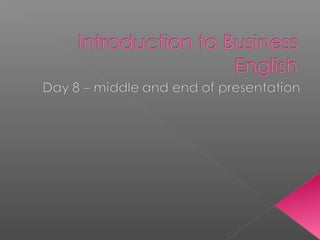
How to Create and Deliver an Effective Presentation
- 2. Any presentation requires a clear strategy or plan to help you reach your objectives. The aim is not to pass away twenty minutes talking non-stop and showing a lot of nice pictures. It is to convey a message that is worth hearing to an audience who want to hear it. However, how many speakers really hold an audience and what they need to know. Plan what you’re going to say and say it clearly and concisely. A good speaker uses various signals to help hold the audience’s attention and make the information clear. One type of singal is to introduce a list with a phrase like there are three things we have to consider. The speaker then says what the three things are and talks about each one at the required level of detail. For example:
- 3. First, economic price. This is based on production costs and the need to make profit… and the speaker goes on to describe this type of price. After that, he goes on to talk about the market price and so on. Another signaling technique is to give a link between parts of the presentation. Say where one part of the talk finishes and another starts. For example, a well organized presentation usually contains different parts and progression from one part to the next must be clear, with phrases like “That’s all I want to say about the development of the product. Now let’s turn to the actual marketing plan.” This technique is very helpful to the audience, including those who are mainly interested in one part only. Another type of signaling is sequencing of information. This usually follows a logical order, perhaps based on time. So a project may be described in terms of the background, the present situation and the future. Key words in sequencing information are first, then, next, after that, later, at the end, finally, etc.
- 4. Still another technique which helps to emphasize key points is careful repetition. Examples are “As I’ve already said, there is no alternative but to increase production by 100% or I’d like to emphasis the main benefit of the new designed – it archives twice as much power with half as much fuel.” A final point concerns timing and quality of information. Psychologists have suggested that the concentration is reduced after about twenty minutes without a break or a change in activity. Furthermore, audiences should not be overburdened with technical details or given too many facts to remember. It is claimed that to ask people to remember more than three things in a five minute talk is too much. Some say that seven is the maximum number of any length of presentation. Any such calculations are probably not very reliable, but every speaker needs to think about exactly how much information of a particular type a specific audience is likely to absorb and to plan accordingly.
- 5. Talking about a problem › Main points › Issues when solving the problem › How it will be or was taken care of. Talking about solutions to the problem › How they fixed the issue Process How they discovered the solution › What are the results then and now › What you hope will happen in the future Remember to keep your parts easy to follow and understand!!
- 6. Which of these two presentations is easier to follow and understand? Why?
- 7. Make sure you have great transitions between different parts of your presentation. Use linking words to help you: › Sequencing words (First, Then, next) › Adding words (and, also, in addition) › Contrasting words (On the other hand, but, others say) › Starting a new ides (Moving on, Let’s now talk about) There are a lot more linking words
- 8. Keep your main ideas prominent and review them multiple time Have something interesting or pronounced in each main idea Don’t linger too much on one item when not necessary. Have enough things to keep people awake.
- 9. Boring information Bad slide design Bad visuals Monotone (voice issues) Not prepared enough Boring story Speakers volume Audience issues (too hot/cold, hungry, tired) Digress too much No body language/ eye contact
- 10. What are the main points of this presentation?
- 11. Always end discussing very briefly the problems and solutions while discussing major items more than the little things. Make your call to action clear and understandable. End positively when necessary. Leave them thinking. Thank them for their time. Ask for questions or discussion if time permits.
- 12. Listen… Which is a better ending? › So I think that’s it. any questions? › Well, that concludes my talk. Let’s now move on to discuss any points you want to talk more on or questions you have.
- 13. Listen again… Make sure to understand the questions that are being given Ask them to repeat the question if you can’t understand or ask for clarification. Take the time to give a good answer. Make sure your answer that satisfies everyone › Confidential › Doesn’t take too long to discuss › Is part of the presentation. › Say you don’t know if you don’t Stay in control End the time politely and Thank them again for the time.
- 14. Listen…. Which is the best of the three? Why?
- 15. Slow Down Be careful of using filler words (um, uh) Don’t just read what is on the slide Short stories and anecdotes are great fillers for time and keeps interest up. Use your voice. Finish early. (but not too early) Have fun.
